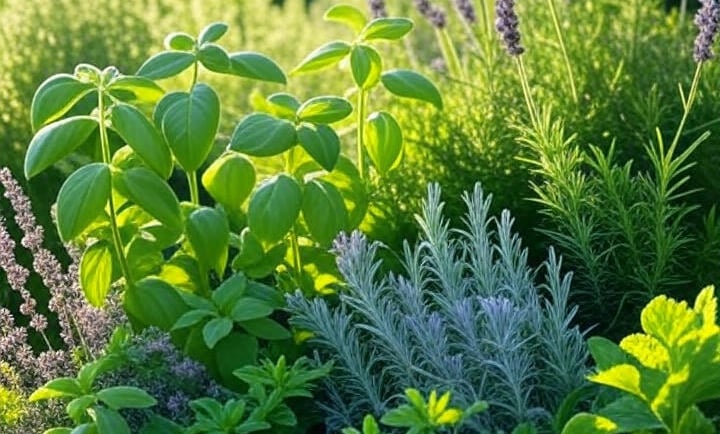Unlocking Nature's Pharmacy: A Deep Dive into Medicinal Herbology
Hey there, fellow nature lover! Imagine wandering through a lush forest where every leaf whispers secrets of healing, every root holds a story of strength, and every flower blooms with the promise of balance. That's the amazing world of medicinal herbology
10/1/20256 min read


Unlocking Nature's Pharmacy: A Deep Dive into Medicinal Herbology
Hey there, fellow nature lover! Imagine wandering through a lush forest where every leaf whispers secrets of healing, every root holds a story of strength, and every flower blooms with the promise of balance. That's the magical world of medicinal herbology – not some dusty old tome, but a vibrant, living tradition that's been empowering humans for millennia. Whether you're battling a pesky cold or just aiming to tune up your body's symphony, herbs are like the ultimate wellness DJs, remixing your health from the inside out. In this post, we'll geek out on how it all works, explore its ripple effects across your body's major systems, unpack what sets it apart from its cousin nutritional herbology, spotlight some powerhouse herbs for your daily glow-up, and wrap with tips to weave this green magic into your routine. Grab your favorite mug (herbal tea optional), and let's get rooted!
The Big Picture: How Medicinal Herbology Works Its Green Magic
At its core, medicinal herbology – also known as herbalism or phytotherapy – harnesses the power of plants to treat ailments, restore balance, and support the body's innate healing processes. Unlike synthetic drugs that often target a single symptom with laser precision, herbs work holistically. They're packed with phytochemicals – think antioxidants, alkaloids, flavonoids, and essential oils – that interact with your body's systems in symphony, not solo.
Here's the lowdown: When you ingest, apply, or inhale an herb, its active compounds are absorbed (via digestion, skin, or lungs) and travel through your bloodstream to influence cellular functions. They might reduce inflammation, boost enzyme production, or modulate hormones, all while promoting homeostasis – that sweet spot where your body hums in harmony. It's not about "curing" overnight; it's about nudging your body back to its wise, self-regulating state. Safety first, though: Herbs can interact with meds, so chat with a pro before diving in.
Herbology's Body Tour: How It Tunes Up Your Major Systems
Herbs don't discriminate – they roll up their sleeves and get to work on every corner of your anatomy. Below, we'll spotlight the big players: cardiovascular, respiratory, digestive, nervous, endocrine, immune, musculoskeletal, reproductive, urinary, and integumentary systems. For each, I'll highlight key effects with example herbs (backed by traditional use and emerging research). Remember, these are supportive tools, not substitutes for medical care.
Cardiovascular System (heart and blood vessels): Herbs like garlic and hawthorn lower blood pressure, improve circulation, and reduce cholesterol by dilating vessels and acting as natural anticoagulants. This eases the heart's workload, potentially slashing risks of heart disease – a game-changer for folks with hypertension.
Respiratory System (lungs and airways): Eucalyptus and thyme clear congestion, soothe inflamed airways, and fight infections with antimicrobial compounds. They're MVPs for asthma or bronchitis, relaxing bronchial muscles and expelling mucus for easier breathing.
Digestive System (stomach, intestines, liver): Ginger and peppermint calm nausea, crampy guts, and bloating by stimulating digestive juices and relaxing smooth muscles. They also support liver detox, aiding in breaking down toxins and easing IBS symptoms.
Nervous System (brain, nerves, spinal cord): Valerian and chamomile dial down anxiety and promote sleep by enhancing GABA (a chill-out neurotransmitter), while ginkgo boosts blood flow to sharpen focus and memory. Ideal for stress-busters in our non-stop world.
Endocrine System (hormones and glands): Ashwagandha and maca balance cortisol and thyroid hormones, combating fatigue and mood swings. They adapt to your body's needs (adaptogens, anyone?), supporting energy without the crash.
Immune System (defenses against invaders): Echinacea and elderberry ramp up white blood cell production and cytokine activity, shortening colds and flu duration. They're like bouncers at your cellular club, keeping pathogens out.
Musculoskeletal System (bones, muscles, joints): Turmeric's curcumin quenches inflammation in arthritis, while comfrey speeds bone healing with allantoin. These herbs ease pain and promote tissue repair for active lifestyles.
Reproductive System (ovaries, testes, uterus): Red raspberry leaf tones uterine muscles for easier periods or pregnancies, and saw palmetto supports prostate health by inhibiting hormone conversion. Gentle allies for hormonal harmony.
Urinary System (kidneys, bladder): Dandelion and nettle act as diuretics, flushing excess fluids and supporting kidney function to prevent stones or infections. They also alkalize urine for better detox.
Integumentary System (skin, hair, nails): Aloe vera and calendula heal wounds and eczema by promoting collagen and antimicrobial action. Topically or internally, they nourish from within for that radiant glow.
Across the board, herbs foster synergy – one might hit multiple systems, amplifying benefits while minimizing side effects when used mindfully.
Medicinal vs. Nutritional Herbology: Spotting the Green Twins' Differences
Ever wondered why your grandma's chamomile tea feels worlds away from a potent echinacea tincture? Medicinal herbology focuses on therapeutic interventions for specific health issues, while nutritional herbology treats herbs as everyday edibles to nourish and prevent. They're siblings in the plant family, but here's a 10-bullet breakdown of their key diffs:
Primary Goal: Medicinal targets treatment of acute or chronic conditions (e.g., using willow bark for pain relief); nutritional emphasizes daily wellness and disease prevention through diet (e.g., basil in salads for antioxidants).
Dosage Intensity: Medicinal often uses concentrated extracts or higher doses for quick effects; nutritional sticks to culinary amounts to avoid overload.
Preparation Methods: Medicinal leans on tinctures, decoctions, or salves for bioavailability; nutritional favors fresh, dried, or powdered forms in meals.
Phytochemical Focus: Medicinal isolates or amplifies therapeutic compounds like alkaloids for symptom relief; nutritional highlights broad-spectrum nutrients like vitamins in herbs as food.
Timeframe of Use: Medicinal is short-term or targeted (e.g., during illness); nutritional is long-term integration for sustained vitality.
Evidence Base: Medicinal draws from clinical trials and pharmacognosy; nutritional roots in dietary epidemiology and whole-food studies.
Holistic Approach: Both are natural, but medicinal often pairs with diagnostics; nutritional embeds in lifestyle nutrition plans.
Risk Profile: Medicinal requires more caution for interactions; nutritional is generally safer as "food medicine" in moderation.
Accessibility: Medicinal might need a herbalist consult; nutritional is DIY via grocery stores and recipes.
Sustainability Angle: Medicinal can strain rare plants if overharvested; nutritional promotes abundant, farm-fresh herbs for eco-friendly eating.
Power-Packed Nutritional Herbs: Your Daily Dose of Green Goodness
Shifting gears to nutritional herbology's stars, these gems pack nutrition punches for prevention and vitality. Here are five standouts, plus easy admin ways to sneak 'em into your day:
Turmeric: Anti-inflammatory curcumin superstar for joint and brain health. Daily hacks: Golden milk latte, curry spice, or supplement capsules.
Ginger: Digestion dynamo and nausea ninja, loaded with gingerol. Daily hacks: Fresh-grated in smoothies, tea bags, or stir-fries.
Garlic: Heart-hero with allicin for immunity and cholesterol control. Daily hacks: Minced in dressings, roasted bulbs, or aged extracts.
Cinnamon: Blood sugar balancer and antioxidant ace. Daily hacks: Sprinkled on oatmeal, in coffee, or as tea.
Basil: Vitamin K-rich mood lifter and detox aid. Daily hacks: Pesto on toast, fresh in salads, or infused water.
From teas to topicals, start small – aim for 1-2 tsp daily – and rotate for variety.
Wrapping the Roots: A Quick Summary and Everyday Applications
In a nutshell, medicinal herbology is your targeted healer, working through phytochemical wizardry to balance body systems from heart to skin, while nutritional herbology keeps the party going with flavorful, preventive eats. Together, they remind us: Nature's got the blueprint for thriving.
Apply it IRL? Swap coffee for ginger tea on Mondays for gut love, dust turmeric on dinners for anti-aging vibes, or brew chamomile post-workout for nervous system TLC. Track how you feel in a journal – small tweaks yield big blooms. Pro tip: Pair with balanced eats, movement, and sleep for max synergy.
Back to the Garden: Your Herbal Happily Ever After
Whew, what a leafy adventure! From forest whispers to your fork, herbology proves we're all just walking, talking ecosystems waiting to flourish. So, next time life throws curveballs, remember: You've got a green army in your corner. Ready to level up? Swing by our new Herbal Backer Shop for the crème de la crème – handcrafted, cold-infused tinctures using certified organic herbs and premium menstruum. No machines, no chemicals, just pure, patient alchemy for potency that sings.
And here's the scoop on why cold-infused beats the heat: Unlike commercial forced-distilled tinctures that blast herbs with high temps (zapping delicate nutrients and volatiles), our cold-pressed method gently coaxes out every bioactive gem over weeks. Result? Fuller-spectrum healing – think preserved antioxidants, smoother absorption, and zero bitterness – without the industrial shortcuts. Your body (and taste buds) will thank you. Head to the shop now and snag your starter kit – nature's calling, and we've got the line open! What's your first herb experiment? Drop it in the comments – let's grow this community. 🌿✨
